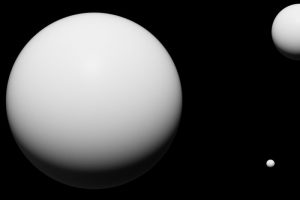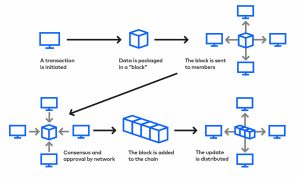Non Fungible Tokens
Written by: Avyay Duggirala
A random computer generated picture of a white planet just sold for 91.8 million dollars. Now you may be thinking: how could that be possible? Well, this event is achievable due to the recent boom in the popularity of non-fungible tokens, better known as NFTs. These seemingly simple pieces of art are being sold for millions of dollars, and you can very easily create your own “collection.” The process to understand and start trading on the NFT market is extremely confusing, but it can be broken down into the artwork, blockchain and transaction.
Figure 1

Image mentioned earlier that sold for 91.8 million dollars
Source: Barrons News
Artwork
The first and most important piece of any NFT is the artwork. NFTs are essentially just pieces of digital artwork that are often linked to physical things. An NFT often works like a picture, where the rights over the picture are sold, with the price varying based on the content and demand for that image. For example, a picture of something basic, like a tree, would sell for much cheaper compared to a rare picture of a sun exploding. The nature of how NFTs are valued is often based on the originality of the artwork. Some NFTs offer benefits along with the artwork, and these NFTs can be thought of as tickets. In fact it could be an actual ticket, like the Bored Ape Yacht Club, where owning a bored ape invites you onto a private yacht. The more affordable NFTs often give you benefits like a special character in a video game or a discount at certain stores. Each NFT is valued on a variety of things, which is part of the reason why their prices are so volatile.
Due to the growing presence of NFTs, this has proved to be a great opportunity for hundreds of artists. NFT markets essentially serve as digital auction houses for the artwork of these artists, bolstering their career and giving them a solid start. This boom has incentivized hundreds of people to recruit artists and create huge NFT projects with the hope of them all being highly valued.
Blockchain
A blockchain is essentially a database that is shared among computer networks that is extremely safe and secure. Blockchain is so popular among crypto currencies because it creates a safe record without the need for a third party, meaning any transaction done through the blockchain is extremely secure. The reason why blockchain is so sought after is due to its difference in structure when compared to a traditional data table. Unlike the static, open, and non-linear structure of a datatable, a blockchain splits up the data given into “blocks.” These blocks are filled with data, and once filled, the block will close and link itself to the previously closed blocks. This sequence is where the chain in the term “blockchain” comes from. Blockchain is very secure because as soon as a block is filled up, it is closed away from editing forever through cryptography, creating a chronological chain of secured blocks of data. This system of blocks allows for a system where no one person has control to hide or remove transactions from the blockchain. Blockchains are growing in popularity as well as applications, and as time progresses, blockchains will likely be used on a far larger scale.
Blockchains are important to NFTs because all NFT transactions are recorded through them, meaning if anyone buys or sells an NFT, you can tell who bought or sold it. This transparency is vital to NFTs to ensure that they aren’t stolen, and that they are legitimate and one-of-a-kind. This process is also why you can’t just screenshot an NFT and claim to own it, because the blockchain will prove you really don’t own the image or artwork. Thus, blockchain is vital to the validity of NFTs, much like a certificate of authenticity for any piece of art.
Figure 2

Steps taken during a transaction that lead to an addition in the blockchain
Source: Slalom
Transactions
The final step in understanding NFTs is comprehending the transactions involving them. NFTs exist mostly on the Ethereum blockchain, which is the blockchain for a common cryptocurrency. On marketplaces using the blockchain, you can either list NFTs for sale or buy NFTs. These marketplaces could be websites or applications. If you decide to buy or sell an NFT, it creates a transaction which is then packaged onto a block. This block is then sent to all of the people involved in the transaction, typically two people. The purchase is then verified by both parties and added to the Ethereum blockchain. After the blockchain is updated, the new owner of an NFT is shown. This entire process is shown in Figure 3. NFTs are Non-Fungible, which means that there is only one of its kind, so only one person can own any given NFT at a time. Because of this characteristic, once the transaction is complete, there will be one new owner of said NFT.
Conclusion
NFTs are becoming significantly more popular and widespread, making it increasingly important to understand the basis of NFTs. First is the artwork, which gives NFTs value and incentivizes artists to create NFTs. Second is the blockchain, the foundation that NFTs and all cryptos are built on. Finally, the transactions themselves are important to understand. Once all three are understood, the basics of NFTs are understood as well.
References and Sources
Clark, M. (2021, March 3). NFTs, explained. The Verge. Retrieved March 16, 2022, from
https://www.theverge.com/22310188/nft-explainer-what-is-blockchain-crypto-art-faq
Conti, R. (2022, February 28). What is an NFT? non-fungible tokens explained. Forbes.
Retrieved March 16, 2022, from
https://www.forbes.com/advisor/investing/nft-non-fungible-token/#:~:text=Essentially%2C%20NFTs%20are%20like%20physical,one%20owner%20at%20a%20time.
Hayes, A. (2022, March 5). Blockchain explained. Investopedia. Retrieved March 16, 2022, from
https://www.investopedia.com/terms/b/blockchain.asp
Rogers, R. (2022, February 14). How to buy and sell NFTS (if you must). Wired. Retrieved
March 16, 2022, from https://www.wired.com/story/how-to-buy-sell-nfts/#:~:text=To%20put%20an%20existing%20NFT,to%20bid%20on%20your%20NFT.
Rossolillo, N. (2021, December 11). How to sell non-fungible tokens (nfts). The Motley Fool.
Retrieved March 16, 2022, from https://www.fool.com/investing/stock-market/market-sectors/financials/non-fungible-tokens/how-to-sell-nfts/#:~:text=Just%20transfer%20the%20NFT%20to,NFT%20you%20want%20to%20sell.